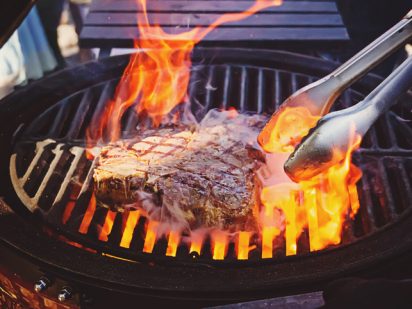By Michelle Fundingsland, RDN, LRD, outpatient dietitian
America’s favorite past time, healthy grilling gets you out of the house, provides a social setting, and lets you cook without adding extra fat. You can grill anything from steak to vegetables to fruit. If that’s not enough, when weather starts to warm up you don’t have to heat up the house with the oven.
Steaks
Steakhouse steaks are higher quality steaks you might find in a restaurant. If you want to pick leaner cuts, choose tenderloin, top sirloin, porterhouse or T-bone, and a smaller size – as close to a 3-ounce cooked portion as possible. When cooking budget-friendly steaks at home, everyday steaks that are leaner choices include round or loin cuts such as the top round, eye of round, round tip, or tri-tip. These cuts may not be as tender as those from the rib or loin, but they can be grilled. They are best prepared with a marinade and not overcooked.
Marinades
A marinade is a seasoned liquid used to add flavor to beef steaks and may help tenderizing, depending on its ingredients. Tenderizing marinades need a food acid such as lemon juice or vinegar, or a natural enzyme found in ingredients such as fresh ginger or fresh pineapple. The acid or enzyme breaks down the muscle fiber and connective tissue of the steak. Flavor marinades only add flavor and do not tenderize. Most marinades only penetrate the meat about a quarter inch, so it’s best to use them with thinner cuts. Use a heavy plastic bag or glass dish to marinate in. Aluminum pans can react to the salt and acids. Allow about 1/4 cup of liquid marinade for each pound of beef. If you use a marinade for tenderizing, do so for six to 24 hours; any longer will result in a mushy texture. If you are marinating for flavor, do so for 15 minutes to two hours.
Rubs
Seasoning blends applied to the surface of steaks before cooking are called rubs. They offer great flavor but do not tenderize the meat. Dry rubs include herbs, spices, and other dry seasonings. Paste-type rubs contain small amounts of wet ingredients like oil, crushed garlic, or mustard. Rubs can be applied to the surface of the beef cut just before cooking, or in advance and refrigerated for several hours.
Fruits and Vegetables
Grilling is not just for meat! Firmer fleshed vegetables, such as zucchini, yellow squash, bell peppers, and new potatoes, are great for skewers. Mushrooms, onions, and cherry tomatoes are also popular. Grilling baskets are available at most retailers if you don’t want to bother with pointy sticks. Other ideas are cauliflower steaks, pineapple rings, and peach halves.
Safety
Don’t forget about grilling safely; check your owner’s manual regarding the safety instructions. Never light a grill indoors, not even in the garage. Once you light up, do not leave your grill.
Food safety is also important; keep your meat and cut vegetables under 40°F until you are ready to cook to prevent bacteria from growing. Keep plenty of ice in your ice chest or keep your meat in the refrigerator until you’re ready to grill.
Cook everything fully. If you enjoy a rare steak, for safety, beef steaks need to reach at least 145°F in the center, which is medium-rare doneness. Ground meats need to be cooked all the way through to 160°F, to kill any bacteria that may have been inside. When cooking, poke your thermometer into the thickest part of the meat. Interior color of the burger is not a 100 percent accurate indicator of doneness. It is suggested to cook until the pink color is gone, but some ground beef can reach 160°F and still have a slight pink tint. Using a thermometer will ensure not only safety, and also better eating quality as you don’t have to overcook the burger.
Don’t reuse marinades or sauces. You don’t want the bacteria from the used marinade to get on your cooked food! You can remove a cup of the marinade before you add the meat or just make a new batch of marinade or sauce.
To minimize carcinogens, clean your grill, don’t let your meat char, use leaner meats (which means less flare-ups), and use a marinade. Marinades don’t drip like barbecue sauces, usually they contain lots of herbs, which can offer more antioxidants.
Avoiding a tough steak
Do not over-cook, and be sure to match the cooking method to the cut of beef. Use grilling time tables for guidelines on how long it will take to grill a certain kind of steak depending on thickness. In general, all beef steaks will be more tender and juicy if cooked to medium-rare doneness. One last tip is to remove the steak about 5°F before the desired doneness, then let the steak “rest” in a warm place (tent with foil). The resting time will help keep the juices in the steak.
Recipe for cauliflower steaks: take one head of cauliflower, cut into 1-inch thick steaks from the center of a cauliflower head. Brush the steaks with olive oil, then grill about 5-6 minutes each side, until golden and tender. Top with your favorite sauce, vegetable, or other garnish.
(Recipe source: www.beefitswhatsfordinner.com)

